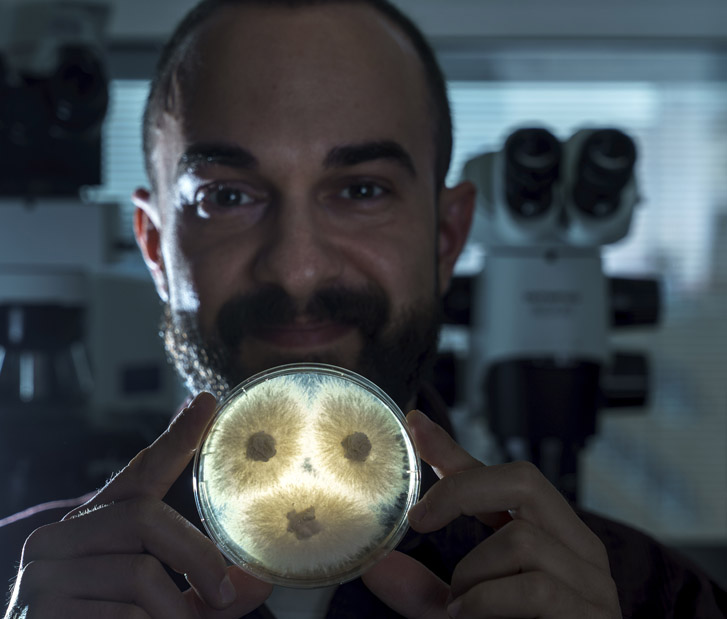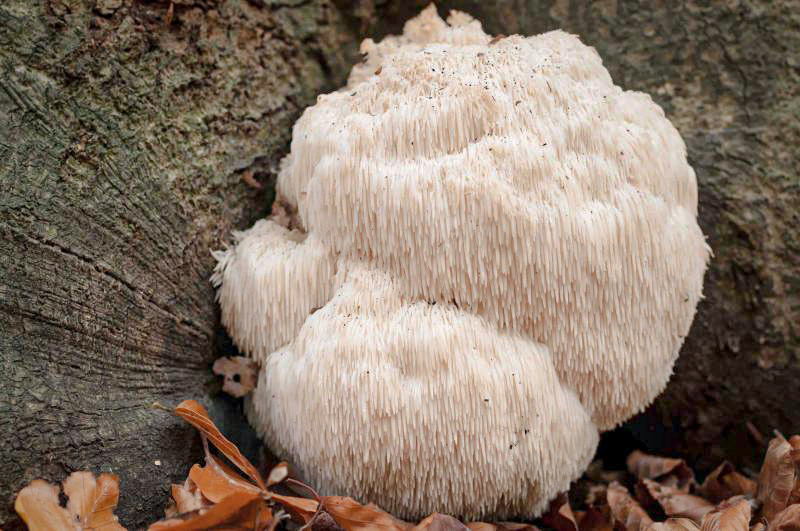
Promising fungi
Will mushrooms cure Alzheimer’s?
The Chinese have known it all along. They’ve been using Lion’s mane – a fungus that occurs everywhere in the Northern Hemisphere – as medicine for thousands of years, in particular to help with memory disorders.
Modern science has become increasingly interested in the properties of this fungus over the past few years. In 2020, a group of Taiwanese researchers showed that the mushroom’s active substances – known as erinacines and hericenones – have a positive effect on people with Alzheimer’s and Parkinson’s disease.
The Lion’s mane is one of these promising fungi that has caught the attention of researchers in the past few years. Not only are fungi the decomposers of nature, organisms that feed on dead or decaying organic material, but they’re also the source of potentially valuable medication, vitamins, and dye pigments.
Fifteen million species
‘The thing is, fungi are cool’, says mycologist Riccardo Iacovelli, post-doctoral researcher at the Faculty of Science and Engineering. ‘There’s no better scientific term to describe them, really. I think we’ve discovered approximately 150,000 species so far, when there are probably anywhere between twelve and fifteen million in total.’
Fungi are cool
In short, it’s a giant treasury of possibility, just waiting to be studied. That’s exactly what Iacovelli and his colleagues from Kristina Haslinger’s research group are doing. They’re using the fungi as little factories to make new molecules. In Iacovelli’s case, he uses the promising hericenones in the Lion’s mane.
His research recently earned him a 50,000 euro ENW-XS grant, a grant awarded to research with high-risk/high-reward potential. ‘That means my plans are pretty risky, but if I’m successful they could be incredibly rewarding.’

Interesting effect
Lion’s mane has an interesting effect on the brain. The active substances encourage the brain to produce more nerve growth factor (NGF), which are needed to grow and maintain neurons. However, Iacovelli explains, after a person turns twenty-five, the brain starts producing increasingly less NGF.
In people with Alzheimer’s, the number of neurons and the connections between the neurons in the brain even decline, often leading to issues with things like speaking or facial recognition.
But what if we could help these people? What if we could do that by simply using the molecules that Lion’s manes are already making on their own?
‘When there’s more NGF in the brain, neurons start growing again. The broken connections between the neurons can also re-grow’, says Iacovelli. ‘Translating this to the brain, we might be able to restore someone’s ability to move their hands or to speak.’
Blood-brain barrier
However, there’s one big problem with NGF: it can’t pass the blood-brain barrier. This barrier prevents harmful substances and bacteria from entering the brain through blood. Unfortunately, it also blocks NGF.
We might be able to restore someone’s ability to speak or move their hands
It looks like the active substances present in Lion’s mane aren’t blocked from entering the brain. ‘We know an effect takes place in both cells and in the brain, but we don’t fully understand it yet. The potential to use the active substances as an anti-Alzheimer’s drug is there, we just have to study it more’, says Iacovelli.
There is, however, another problem: Lion’s mane mushrooms only produce a small amount of active substances, which means you’d need an immense amount of mushroom for it to have any effect. ‘I thought it might be interesting to figure out how these fungi produce the molecules’, says Iacovelli. ‘Then, we could utilise fast-growing model fungi to do the same thing but in much larger quantities.’
Microbial cell factory
Last year, he came across a study that had information about the mushroom’s DNA. It provided a boost to his plans. Now, Iacovelli was able to find exactly those bits of Lion’s mane DNA that produced hericenones.
It’s important that we start seeing the enormous potentials of fungi
He then used genetic modification to create a microbial cell factory, in which simple laboratory fungi produce the active substances. ‘It’s kind of like cutting and pasting using scissors and tape’, he says. ‘You cut the important bit from the Lion’s mane DNA and paste it into the DNA of a lab fungus.’
This process is still in full swing. The Lion’s mane produces its hericenones in seven separate steps, and Iacovelli has to recreate every single one in his lab. Each step causes his laboratory fungus to produce a new enzyme that slowly turns the starter molecule into the final product: hericenone.
‘We’ve discovered the first step!’ Iacovelli enthuses. ‘It’s working great, so there’s a good chance the other six will be a success as well.’
Collaboration
For now, he’ll be concentrating on those next steps. He doesn’t know how long the whole process will take. ‘If we’re lucky, it could be anywhere between two months and five years.’
When he’s done, he should have a method to cheaply produce large amounts of hericenones. ‘For that, I’d want to collaborate with people who study the growth of fungi in industrial environments’, says Iacovelli. But that’s something for later. ‘It could easily be another twenty years before there’s a commercially available drug on the market.’
In the meantime, he’ll continue to study his fungi. ‘There’s so much we can learn from fungi, and so many applications to explore’, he says. ‘It’s important that we start seeing the enormous potential of fungi and learn to appreciate it.’
‘Right now, many different places are trying to figure out if we can use fungi for making clothes, for example, or paint, meat substitutes, or natural pesticides.’ He expects that by the end of this century, many more products will be derived from fungi: ‘I’m looking forward to it.’